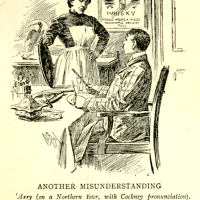 I am certain that within long I will be accused of being obsessed with Prefaces. I have posted great prefaces to C.S. Lewis’ The Allegory of Love and Madeleine L’Engle’s A Wrinkle in Time, and I have even published the earliest manuscript of Lewis’ preface to The Screwtape Letters. Now I’m at it again.
I am certain that within long I will be accused of being obsessed with Prefaces. I have posted great prefaces to C.S. Lewis’ The Allegory of Love and Madeleine L’Engle’s A Wrinkle in Time, and I have even published the earliest manuscript of Lewis’ preface to The Screwtape Letters. Now I’m at it again.
In my defense, a preface, foreword, or introduction to a book often has some of the best stuff in the most condensed form. It is what an author says when she is tired of saying things, and mostly wants to find a way to get a reader connected to her material. I always encourage students to look at prefatory material before they dive in to the meat of the book.
Well, I’m at it again. I am reading That Hideous Strength, the conclusion of the Ransom Cycle that began with Out of the Silent Planet. It is an intriguing book, one part Arthuriana, one part science fiction, and one part dystopian farce. It is rich in references to other authors, from the Bible and Aristotle to H.G. Wells and Jules Verne to J.R.R. Tolkien and Charles Williams. And it explores in most detail the inner psychology of human characters in all his books, with the exception of Till We Have Faces. It is a peculiar ending to the Ransom Cycle, longer than all the other Ransom books put together and concluded with the aid of an awoken Merlin. But it is an excellent book, and worth digging into.
 It is probably surprising, then, that this psychologically complex, dark, contemporary science fiction novel is actually called That Hideous Strength: A Modern Fairy-Tale for Grown-Ups. Even in the title there are intertextual hints. The subtitle is very much like George MacDonald’s, Phantastes: A Faerie Romance for Men and Women–a book that had incalculable influence on Lewis. The title, That Hideous Strength, is drawn from a 16th century David Lindsay poem about the Tower of Babel:
It is probably surprising, then, that this psychologically complex, dark, contemporary science fiction novel is actually called That Hideous Strength: A Modern Fairy-Tale for Grown-Ups. Even in the title there are intertextual hints. The subtitle is very much like George MacDonald’s, Phantastes: A Faerie Romance for Men and Women–a book that had incalculable influence on Lewis. The title, That Hideous Strength, is drawn from a 16th century David Lindsay poem about the Tower of Babel:
“The shadow of that hyddeous strength
Sax myle and more it is of length”
A Dialog, Sir David Lindsay
 I knew of the Lindsay reference when picking up the book, and was surprised that it was not an epigraph to my copy. I was certain that it was. I did some digging and discovered that my ePub version had the Lindsay reference, but my paper copies do not. Both versions dedicate the book to J. McNeill, a longtime of Lewis’ that he called “Janie” (pronounced Tchainie). But only the digital copy has the epigraph.
I knew of the Lindsay reference when picking up the book, and was surprised that it was not an epigraph to my copy. I was certain that it was. I did some digging and discovered that my ePub version had the Lindsay reference, but my paper copies do not. Both versions dedicate the book to J. McNeill, a longtime of Lewis’ that he called “Janie” (pronounced Tchainie). But only the digital copy has the epigraph.
Then I began reading the preface and noticed another difference. It was different than the one I remembered. As I dug around a bit, I discovered that there are two different prefaces to That Hideous Strength. One was published with the book and is signed “Christmas Eve, 1943”–according to his custom of dating prefaces–and one appears later. The first edition preface is longer, and mostly involved in setting the context to the story. The later preface is much shorter, and has a strange concluding paragraph that pokes fun at the length.
 I thought it would be fun to post both prefaces. This has the very serious reason of allowing readers to compare the two different prefaces side by side. It will also allow readers the chance to school me on where this second, shorter preface came from. Lewis would sometimes rewrite prefaces when new editions came out, as he did for The Pilgrim’s Regress in 1958. His fame increased with the publication of Narnia, so a number of his older books were re-released in the following decade.
I thought it would be fun to post both prefaces. This has the very serious reason of allowing readers to compare the two different prefaces side by side. It will also allow readers the chance to school me on where this second, shorter preface came from. Lewis would sometimes rewrite prefaces when new editions came out, as he did for The Pilgrim’s Regress in 1958. His fame increased with the publication of Narnia, so a number of his older books were re-released in the following decade.
These are good, serious reasons to post these prefaces. But there is also an entirely indulgent reason. It gives me a chance to show some of the varieties of cover art for That Hideous Strength. Although none of them border on realism, some of the imaginative scope of old SciFi art is dominant in these older book covers.
Enjoy the crazy cover designs as well as the side-by-side comparison of the prefaces. And do let me know if you have information on the provenance of the second preface.
That Hideous Strength: A Modern Fairy-Tale for Grown-Ups
I have called this a ‘fairy tale’ in the hope that no one who dislikes fantasy may be misled first two chapters into reading further, and then complain of his disappointment. If you ask why—intending to write about magicians, devils, pantomime animals, and planetary angels, I nevertheless begin with such humdrum scenes and persons—reply that I am following the traditional fairy-tale. We do not always notice its method because the cottages, castles, woodcutters, and petty kings with which a fairy-tale opens have become to us as remote as the witches and ogres to which it proceeds. But they were not remote at all to the men who made and first enjoyed the stories. They were indeed more realistic or common place than Bracton College is to me: for many German peasants had actually met cruel stepmothers, whereas I have never, in any university, come across a college like Bracton.
 This is a ‘tall story’ about devilry, though it has behind it a serious ‘point’ which I have tried to make in my ‘Abolition of Man.’ In the story the outer rim of that devilry had to be shown touching the life of some ordinary and respectable profession. I selected my own profession, not, of course, because I think Fellows of Colleges more likely to be thus corrupted than anyone else, but because my own profession I know well enough to write about. A very small university is imagined because that has certain conveniences for fiction. Edgestow has no resemblance, save for its smallness, to Durham—a university with which the only connection I have ever had was entirely pleasant.
This is a ‘tall story’ about devilry, though it has behind it a serious ‘point’ which I have tried to make in my ‘Abolition of Man.’ In the story the outer rim of that devilry had to be shown touching the life of some ordinary and respectable profession. I selected my own profession, not, of course, because I think Fellows of Colleges more likely to be thus corrupted than anyone else, but because my own profession I know well enough to write about. A very small university is imagined because that has certain conveniences for fiction. Edgestow has no resemblance, save for its smallness, to Durham—a university with which the only connection I have ever had was entirely pleasant.
I believe that one of the central ideas of this tale came into my head from conversations I had with a scientific colleague, some time before I met a rather similar suggestion in the works of Mr. Olaf Stapledon. If I am mistaken in this, Mr. Stapledon is so rich in invention that he can well afford to lend, and I admire his invention (though not his philosophy) so much that I should feel no shame to borrow.
 Those who would like to learn further about Numinor and the True West must (alas!) await the publication of much that still exists only in the MSS. of my friend, Professor J. R. R. Tolkien. The period of this story is vaguely “after the war.” It concludes the trilogy of which Out of the Silent Planet was the first part, and Perelandra the second, but can be read on its own.
Those who would like to learn further about Numinor and the True West must (alas!) await the publication of much that still exists only in the MSS. of my friend, Professor J. R. R. Tolkien. The period of this story is vaguely “after the war.” It concludes the trilogy of which Out of the Silent Planet was the first part, and Perelandra the second, but can be read on its own.
C.S. Lewis, Madgalen College, Oxford, Christmas Eve, 1943.
Later Shortened Preface
 This is a ‘tall story’ about devilry, though it has behind it a serious ‘point’ which I have tried to make in my Abolition of Man. In the story the outer rim of that devilry had to be shown touching the life of some ordinary and respectable profession. I selected my own profession, not, of course, because I think Fellows of Colleges more likely to be thus corrupted than anyone else, but because my own profession is naturally that which I know best. A very small university is imagined because that has certain conveniences for fiction. Edgestow has no resemblance, save for its smallness, to Durham – a university with which the only connection I have ever had was entirely pleasant.
This is a ‘tall story’ about devilry, though it has behind it a serious ‘point’ which I have tried to make in my Abolition of Man. In the story the outer rim of that devilry had to be shown touching the life of some ordinary and respectable profession. I selected my own profession, not, of course, because I think Fellows of Colleges more likely to be thus corrupted than anyone else, but because my own profession is naturally that which I know best. A very small university is imagined because that has certain conveniences for fiction. Edgestow has no resemblance, save for its smallness, to Durham – a university with which the only connection I have ever had was entirely pleasant.
In reducing the original story to a length suitable for this edition, I believe I have altered nothing but the tempo and the manner. I myself prefer the more leisurely pace-I would not wish even War and Peace or The Faerie Qyeene any shorter-but some critics may well think this abridgment is also an improvement.



























This is wonderful! As far as I know about the origin of the second preface is that it is the preface to “The Tortured Planet,” which is an abridgment of “That Hideous Strength.” Lewis authorized the abridgment and hence this line: “In reducing the original story to a length suitable for this edition, I believe I have altered nothing but the tempo and the manner. ” I believe that is where the different preface comes from!
Thanks,
Dave Gillespie
I agree with you about the importance of prefatory material. Sometimes it contains true gems, and often it gives meaning to the underlying themes the author desires to make.
I can confirm David’s assertion that the second one is in The Tortured Planet edition of That Hideous Strength (which is an abridged version that Lewis approved).
Speaking of abridged versions, did you know that there is one for MIRACLES! It came out in 1958 before he revised the third chapter and it has the SAME title of Miracles: A Preliminary Study.
Sort of a trap, isn’t it! I bought “God in the Dock” only to find out I was missing half the real essays. Too bad.
Thanks for the note on the Tortured Planet. Do you have it William?
Yes. Two copies actually.
You did know there where two versions of God in the Dock? Wait there’s actually three. Maybe I need to do an article about this? Maybe a guest post?
This would be a great article for you to write as a guest blog for a Pilgrim in Narnia! What madness: multiple editions, same names…. A death trap for innocent readers.
Your wish is my command! Although I actually don’t know what that expression means…
Anyway, because of informally collecting this information in a file already I can dust that off and create something for you. Not sure when I might finish it, but I like these kinds of things and will throw it up in the air to juggle with the rest of the projects.
Speak of projects…and you get the first public mention here…I’m working on doing a short series podcast on the C.S. Lewis vs the New Atheists book by Peter S. Williams….I’ve very excited about it!
That’s very fun. I was an inch away from doing my career specialty in the New Atheists, but I just didn’t find them interesting enough. Good podcast idea. I think I’ll re-listen to your Planet Narnia cast.
And let me know when you have a guest blog! Of course, you should do it as a 2 for 1, posting it on your own too. I noted your Perelandra query. Well done.
Hahah, man, I love Lewis.
I think the second preface makes sense in terms of simple editing, especially if it accompanied an abridgement. Like Lewis, I enjoy a leisurely pace in my reading and writing, though I am exercising self-discipline in trying to keep my current WIP to more modern standards of pace.
I don`t prefer reading rushed books, either. Writing, I like shorter pieces, falling naturally into 75,000-100,000 words. My 3 Day Novel pieces are all 35,000-45,000 words, but I don’t know what to do with them when they are done. They’re not novels, and not novellas.
I’m not convinced they need to fall into one or the other category. The only question of importance is, do you like them enough to polish them into publish-ready material? 🙂
Some of them I like. Finding the time to do it is becoming tough… Some I will let lie in digital form.
Also, did you mean “Pilgrim’s Progress” or “Pilgrim’s Regress?”
Ah, well done. I fixed that mental gaff.
Those are interesting to look at side by side. I prefer the first version – I think it gives a better idea of what is to come and why it is there.
Me too, very much so. The shorter one seems a bit half-hearted even. But both have Lewis’ subtle humour.
Pingback: On Mixing Fantasy with Real Life, A Lesson from Sesame Street (#WritingWednesdays) | A Pilgrim in Narnia
Pingback: Till We Have Confusing Book Titles: Guest Post by William O’Flaherty | A Pilgrim in Narnia
Pingback: The Fictional Universe of Narnia | A Pilgrim in Narnia
Am I right in remembering that Lewis abridged the novel himself for the short version?
I remember Colman O’Hare had an interesting comparison of the two in his doctoral dissertation, which I think is still available in some form from the National Library of Canada, though not, alas, online. As I remember it, he was focussed on testing Lewis’s debt to/interrelation with Willams’s late verse Arthurian retelling, the quotations from which are one of the things cut in abridgement.
You are right that the abridgement was Lewis’, and he probably did one for Perelandra, but I don’t know it exists.
I’ll hunt down that thesis.
Pingback: Digital Dust? Thoughts on my 300th Post | A Pilgrim in Narnia
Pingback: 2014: A Year of Reading | A Pilgrim in Narnia
Pingback: Guest Blog: C.S. Lewis Goes to Heaven: William O’Flaherty’s Interview with David Clark | A Pilgrim in Narnia
Pingback: Why is Merlin in That Hideous Strength? | A Pilgrim in Narnia
Pingback: The Stories behind Jane Austen’s Pride & Prejudice | A Pilgrim in Narnia
Pingback: What I’m Reading Wednesday | A Pilgrim in Narnia
Pingback: From The Hobbit to Harry Potter, From Fairy Tale to Epic | A Pilgrim in Narnia
Pingback: A Year of Reading Lewis: That Hideous Strength | the traveller's path
Pingback: How the Classic SciFi Superstars Helped C.S. Lewis Fall in Love with Science Fiction Again | A Pilgrim in Narnia
Pingback: On a Picture by Chirico: A Controversial Suggestion about the Creation of Narnia | A Pilgrim in Narnia
Pingback: “So Multifarious and So True”: The C.S. Lewis Blurb for the Fellowship of the Ring | A Pilgrim in Narnia
Pingback: Feature Friday: “Met Without Chests”: A C.S. Lewis Doodle | A Pilgrim in Narnia
Pingback: George Orwell’s 1984 and C.S. Lewis’ That Hideous Strength: A Conversation about Influence and Pride of Place | A Pilgrim in Narnia
Pingback: Orwellian Advice: A Guest Post by the Mere Inkling | A Pilgrim in Narnia
Pingback: The Transformative Power of Memory: Lewis and the Great Wars #LestWeForget | A Pilgrim in Narnia
Pingback: A Manuscript List and Timeline of The Screwtape Letters | A Pilgrim in Narnia
Pingback: The Transformative Power of Memory: Lewis and the World Wars | A Pilgrim in Narnia
Pingback: Losing the Safety of the Real in That Hideous Strength | A Pilgrim in Narnia
Pingback: What is the Significance of Worc(h)ester in C.S. Lewis’ Ransom Cycle? | A Pilgrim in Narnia
Pingback: C.S. Lewis’ Christmas Sermon for Pagans (Friday Feature) | A Pilgrim in Narnia
Pingback: ‘The Name is Against Them’: C.S. Lewis and the Problem of Arthur by Gabriel Schenk | A Pilgrim in Narnia
Pingback: Little Rooms of Imagination with Madeleine L’Engle and C.S. Lewis (Friday Feature) | A Pilgrim in Narnia
Pingback: The Inklings and Arthur Series Index | A Pilgrim in Narnia
Pingback: The Inklings and King Arthur: Selfies and News | A Pilgrim in Narnia
Pingback: “Not Because I am Anyone in Particular”: C.S. Lewis’ Original Preface to The Broadcast Talks (1942) | A Pilgrim in Narnia
Pingback: The C.S. Lewis Studies Series: Part 5: Recent and Foundational Studies on Lewis and Gender | A Pilgrim in Narnia
Pingback: The C.S. Lewis Studies Series: Where It’s Going and How You Can Contribute | A Pilgrim in Narnia
Pingback: “Can C.S. Lewis and L.M. Montgomery be Kindred Spirits?” My Talk for the 2021 C.S. Lewis & Kindred Spirits Society Conference (Nov 18-20) and How You Can Go to Romania With Me | A Pilgrim in Narnia
Pingback: “The Nightmare Alley of That Hideous Strength: A Look at C.S. Lewis and William Gresham” by By G. Connor Salter (Nightmare Alley Series) | A Pilgrim in Narnia
Pingback: “The 80th Anniversary of C.S. Lewis’ The Screwtape Letters” by Brenton Dickieson | A Pilgrim in Narnia
Pingback: C.S. Lewis’ Christmas Sermon for Pagans in the Strand | A Pilgrim in Narnia